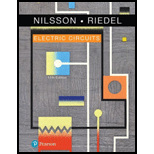
Electric Circuits. (11th Edition)
11th Edition
ISBN: 9780134746968
Author: James W. Nilsson, Susan Riedel
Publisher: PEARSON
expand_more
expand_more
format_list_bulleted
Question
Chapter 7, Problem 26P
a)
To determine
Find the total dissipated energy in
b)
To determine
Find the time taken by the capacitor to dissipate
Expert Solution & Answer
Learn your wayIncludes step-by-step video

schedule09:09
Chapter 7 Solutions
Electric Circuits. (11th Edition)
Ch. 7.1 - The switch in the circuit shown has been closed...Ch. 7.1 - Prob. 2APCh. 7.2 - Prob. 3APCh. 7.2 - Prob. 4APCh. 7.3 - Prob. 5APCh. 7.3 - Prob. 6APCh. 7.4 - Prob. 7APCh. 7.4 - Prob. 8APCh. 7.5 - Prob. 9APCh. 7.5 - Prob. 10AP
Ch. 7.7 - There is no energy stored in the capacitor at the...Ch. 7.7 - Prob. 12APCh. 7 - Prob. 1PCh. 7 - In the circuit shown in Fig. P 7.2, the switch...Ch. 7 - Prob. 3PCh. 7 - The switch shown in Fig. P 7.4 has been open for a...Ch. 7 - Prob. 5PCh. 7 - For the circuit of Fig. P 7.5, what percentage of...Ch. 7 - Prob. 7PCh. 7 - In the circuit in Fig. P 7.8, the voltage and...Ch. 7 - Prob. 9PCh. 7 - Prob. 10PCh. 7 -
The switch in the circuit seen in Fig. P 7.11 has...Ch. 7 - In the circuit in Fig. P 7.11, let Ig represent...Ch. 7 - The two switches in the circuit seen in Fig. P...Ch. 7 - Prob. 14PCh. 7 - Prob. 15PCh. 7 - Prob. 16PCh. 7 - Prob. 17PCh. 7 - Prob. 18PCh. 7 - Prob. 19PCh. 7 - For the circuit seen in Fig. P 7.19, find
the...Ch. 7 - Prob. 21PCh. 7 - Prob. 22PCh. 7 - Prob. 23PCh. 7 - Prob. 24PCh. 7 - The switch in the circuit in Fig. P 7.25 is closed...Ch. 7 - In the circuit shown in Fig. P 7.26, both switches...Ch. 7 -
In the circuit in Fig. P 7.27 the voltage and...Ch. 7 - Prob. 28PCh. 7 - Prob. 29PCh. 7 - The switch in the circuit seen in Fig. P 7.30 has...Ch. 7 - In Problem 7.30 how many microjoules of energy are...Ch. 7 - Prob. 33PCh. 7 - Prob. 34PCh. 7 - Prob. 35PCh. 7 - Prob. 36PCh. 7 - Prob. 37PCh. 7 - The switch in the circuit shown in Fig. P 7.38 has...Ch. 7 - Prob. 39PCh. 7 - Prob. 40PCh. 7 - Prob. 41PCh. 7 - Prob. 42PCh. 7 - Prob. 43PCh. 7 - Prob. 44PCh. 7 - Prob. 45PCh. 7 - Prob. 46PCh. 7 - For the circuit in Fig. P 7.4, find (in...Ch. 7 - Prob. 48PCh. 7 - Prob. 49PCh. 7 - Prob. 50PCh. 7 - Prob. 51PCh. 7 - Prob. 52PCh. 7 - Prob. 53PCh. 7 - Prob. 54PCh. 7 - The switch in the circuit of Fig. P 7.55 has been...Ch. 7 - The switch in the circuit seen in Fig. P 7.56 has...Ch. 7 - Prob. 57PCh. 7 - Prob. 58PCh. 7 - Prob. 59PCh. 7 - The switch in the circuit shown in Fig. P 7.61 has...Ch. 7 - Prob. 62PCh. 7 - Prob. 63PCh. 7 - Prob. 64PCh. 7 - Prob. 65PCh. 7 - Prob. 66PCh. 7 - Prob. 67PCh. 7 - Prob. 68PCh. 7 - Prob. 69PCh. 7 - Prob. 70PCh. 7 - Prob. 71PCh. 7 - Prob. 72PCh. 7 - Prob. 73PCh. 7 - For the circuit in Fig. P 7.73, how many...Ch. 7 - Prob. 75PCh. 7 - Prob. 76PCh. 7 - Prob. 77PCh. 7 - Prob. 78PCh. 7 - Prob. 79PCh. 7 - Prob. 80PCh. 7 - Prob. 81PCh. 7 - Prob. 82PCh. 7 - Prob. 84PCh. 7 - Prob. 85PCh. 7 - Prob. 86PCh. 7 - Prob. 87PCh. 7 - Prob. 88PCh. 7 - Prob. 90PCh. 7 - Prob. 91PCh. 7 - Prob. 92PCh. 7 - Prob. 93PCh. 7 - Prob. 94PCh. 7 - Prob. 95PCh. 7 - Prob. 100PCh. 7 - Prob. 101PCh. 7 - Prob. 102PCh. 7 - Prob. 103PCh. 7 - Prob. 104PCh. 7 - Prob. 105PCh. 7 - Prob. 106PCh. 7 - Prob. 107P
Additional Engineering Textbook Solutions
Find more solutions based on key concepts
Find the color code for the following 10% resistors: 68 0.33 22k 5.6M
Introductory Circuit Analysis (13th Edition)
Find the equivalent capacitance for each of the circuits shown in Figure P3.24. Figure P3.24
Electrical Engineering: Principles & Applications (7th Edition)
An electron with a speed of 8 106 m/s is projected along the positive x direction into a medium containing a u...
Fundamentals of Applied Electromagnetics (7th Edition)
Write a loop equivalent to the for loop above without using .
C Programming Language
Design a nonrecursive algorithm to replace the recursive one represented in Figure 8.21. def Search(Tree, Targe...
Computer Science: An Overview (13th Edition) (What's New in Computer Science)
Give a general description of the input validation process.
Starting Out with Programming Logic and Design (4th Edition)
Knowledge Booster
Learn more about
Need a deep-dive on the concept behind this application? Look no further. Learn more about this topic, electrical-engineering and related others by exploring similar questions and additional content below.Recommended textbooks for you
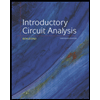 Introductory Circuit Analysis (13th Edition)Electrical EngineeringISBN:9780133923605Author:Robert L. BoylestadPublisher:PEARSON
Introductory Circuit Analysis (13th Edition)Electrical EngineeringISBN:9780133923605Author:Robert L. BoylestadPublisher:PEARSON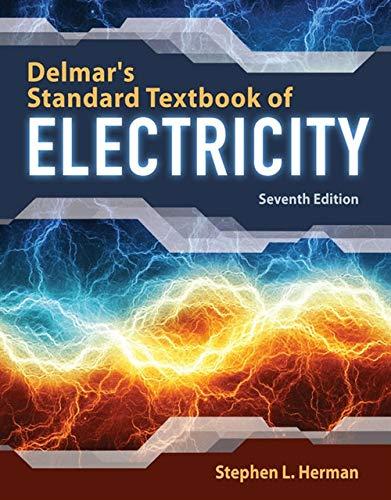 Delmar's Standard Textbook Of ElectricityElectrical EngineeringISBN:9781337900348Author:Stephen L. HermanPublisher:Cengage Learning
Delmar's Standard Textbook Of ElectricityElectrical EngineeringISBN:9781337900348Author:Stephen L. HermanPublisher:Cengage Learning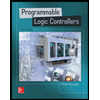 Programmable Logic ControllersElectrical EngineeringISBN:9780073373843Author:Frank D. PetruzellaPublisher:McGraw-Hill Education
Programmable Logic ControllersElectrical EngineeringISBN:9780073373843Author:Frank D. PetruzellaPublisher:McGraw-Hill Education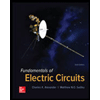 Fundamentals of Electric CircuitsElectrical EngineeringISBN:9780078028229Author:Charles K Alexander, Matthew SadikuPublisher:McGraw-Hill Education
Fundamentals of Electric CircuitsElectrical EngineeringISBN:9780078028229Author:Charles K Alexander, Matthew SadikuPublisher:McGraw-Hill Education Electric Circuits. (11th Edition)Electrical EngineeringISBN:9780134746968Author:James W. Nilsson, Susan RiedelPublisher:PEARSON
Electric Circuits. (11th Edition)Electrical EngineeringISBN:9780134746968Author:James W. Nilsson, Susan RiedelPublisher:PEARSON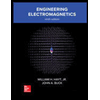 Engineering ElectromagneticsElectrical EngineeringISBN:9780078028151Author:Hayt, William H. (william Hart), Jr, BUCK, John A.Publisher:Mcgraw-hill Education,
Engineering ElectromagneticsElectrical EngineeringISBN:9780078028151Author:Hayt, William H. (william Hart), Jr, BUCK, John A.Publisher:Mcgraw-hill Education,

Introductory Circuit Analysis (13th Edition)
Electrical Engineering
ISBN:9780133923605
Author:Robert L. Boylestad
Publisher:PEARSON

Delmar's Standard Textbook Of Electricity
Electrical Engineering
ISBN:9781337900348
Author:Stephen L. Herman
Publisher:Cengage Learning

Programmable Logic Controllers
Electrical Engineering
ISBN:9780073373843
Author:Frank D. Petruzella
Publisher:McGraw-Hill Education

Fundamentals of Electric Circuits
Electrical Engineering
ISBN:9780078028229
Author:Charles K Alexander, Matthew Sadiku
Publisher:McGraw-Hill Education

Electric Circuits. (11th Edition)
Electrical Engineering
ISBN:9780134746968
Author:James W. Nilsson, Susan Riedel
Publisher:PEARSON

Engineering Electromagnetics
Electrical Engineering
ISBN:9780078028151
Author:Hayt, William H. (william Hart), Jr, BUCK, John A.
Publisher:Mcgraw-hill Education,
Systems and Simulation - Lecture 3: Modelling of Mechanical systems; Author: bioMechatronics Lab;https://www.youtube.com/watch?v=fMcDdyoC9mA;License: Standard Youtube License